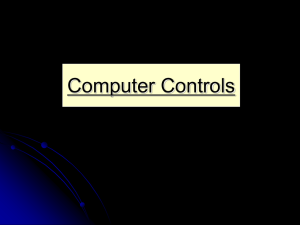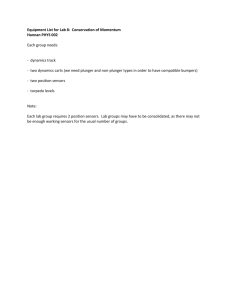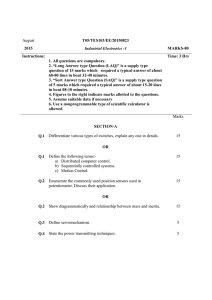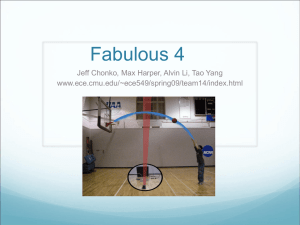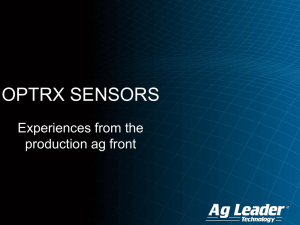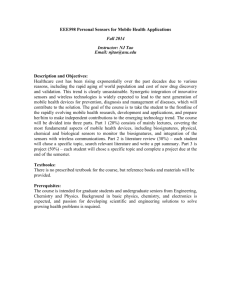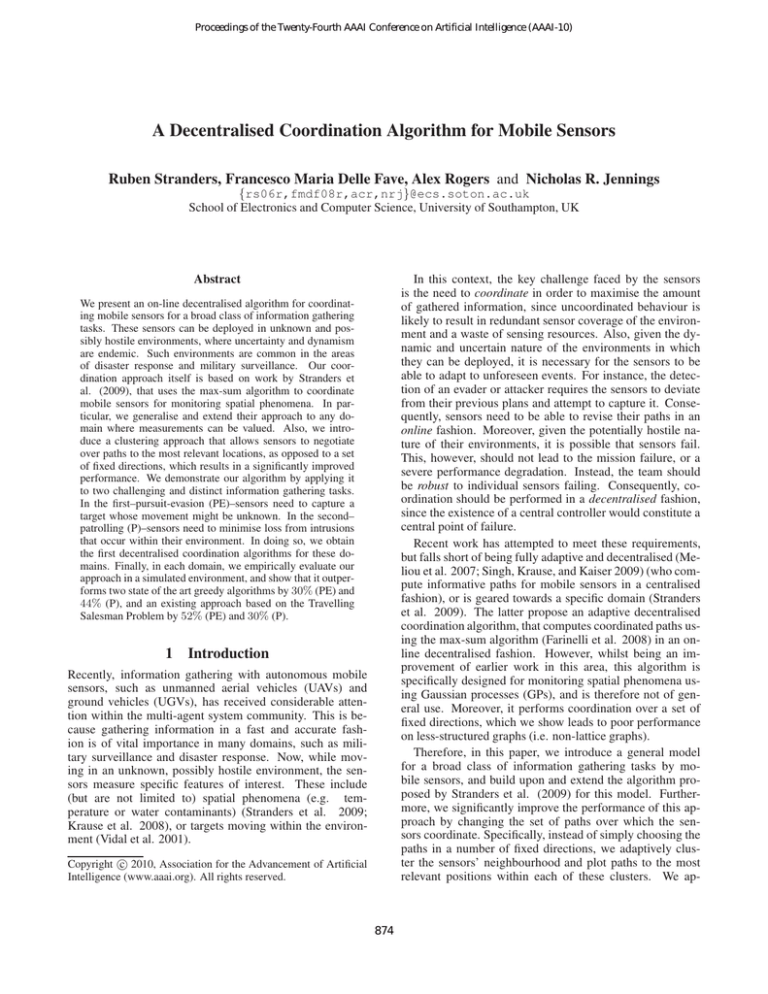
Proceedings of the Twenty-Fourth AAAI Conference on Artificial Intelligence (AAAI-10)
A Decentralised Coordination Algorithm for Mobile Sensors
Ruben Stranders, Francesco Maria Delle Fave, Alex Rogers and Nicholas R. Jennings
{rs06r,fmdf08r,acr,nrj}@ecs.soton.ac.uk
School of Electronics and Computer Science, University of Southampton, UK
Abstract
In this context, the key challenge faced by the sensors
is the need to coordinate in order to maximise the amount
of gathered information, since uncoordinated behaviour is
likely to result in redundant sensor coverage of the environment and a waste of sensing resources. Also, given the dynamic and uncertain nature of the environments in which
they can be deployed, it is necessary for the sensors to be
able to adapt to unforeseen events. For instance, the detection of an evader or attacker requires the sensors to deviate
from their previous plans and attempt to capture it. Consequently, sensors need to be able to revise their paths in an
online fashion. Moreover, given the potentially hostile nature of their environments, it is possible that sensors fail.
This, however, should not lead to the mission failure, or a
severe performance degradation. Instead, the team should
be robust to individual sensors failing. Consequently, coordination should be performed in a decentralised fashion,
since the existence of a central controller would constitute a
central point of failure.
Recent work has attempted to meet these requirements,
but falls short of being fully adaptive and decentralised (Meliou et al. 2007; Singh, Krause, and Kaiser 2009) (who compute informative paths for mobile sensors in a centralised
fashion), or is geared towards a specific domain (Stranders
et al. 2009). The latter propose an adaptive decentralised
coordination algorithm, that computes coordinated paths using the max-sum algorithm (Farinelli et al. 2008) in an online decentralised fashion. However, whilst being an improvement of earlier work in this area, this algorithm is
specifically designed for monitoring spatial phenomena using Gaussian processes (GPs), and is therefore not of general use. Moreover, it performs coordination over a set of
fixed directions, which we show leads to poor performance
on less-structured graphs (i.e. non-lattice graphs).
Therefore, in this paper, we introduce a general model
for a broad class of information gathering tasks by mobile sensors, and build upon and extend the algorithm proposed by Stranders et al. (2009) for this model. Furthermore, we significantly improve the performance of this approach by changing the set of paths over which the sensors coordinate. Specifically, instead of simply choosing the
paths in a number of fixed directions, we adaptively cluster the sensors’ neighbourhood and plot paths to the most
relevant positions within each of these clusters. We ap-
We present an on-line decentralised algorithm for coordinating mobile sensors for a broad class of information gathering
tasks. These sensors can be deployed in unknown and possibly hostile environments, where uncertainty and dynamism
are endemic. Such environments are common in the areas
of disaster response and military surveillance. Our coordination approach itself is based on work by Stranders et
al. (2009), that uses the max-sum algorithm to coordinate
mobile sensors for monitoring spatial phenomena. In particular, we generalise and extend their approach to any domain where measurements can be valued. Also, we introduce a clustering approach that allows sensors to negotiate
over paths to the most relevant locations, as opposed to a set
of fixed directions, which results in a significantly improved
performance. We demonstrate our algorithm by applying it
to two challenging and distinct information gathering tasks.
In the first–pursuit-evasion (PE)–sensors need to capture a
target whose movement might be unknown. In the second–
patrolling (P)–sensors need to minimise loss from intrusions
that occur within their environment. In doing so, we obtain
the first decentralised coordination algorithms for these domains. Finally, in each domain, we empirically evaluate our
approach in a simulated environment, and show that it outperforms two state of the art greedy algorithms by 30% (PE) and
44% (P), and an existing approach based on the Travelling
Salesman Problem by 52% (PE) and 30% (P).
1 Introduction
Recently, information gathering with autonomous mobile
sensors, such as unmanned aerial vehicles (UAVs) and
ground vehicles (UGVs), has received considerable attention within the multi-agent system community. This is because gathering information in a fast and accurate fashion is of vital importance in many domains, such as military surveillance and disaster response. Now, while moving in an unknown, possibly hostile environment, the sensors measure specific features of interest. These include
(but are not limited to) spatial phenomena (e.g. temperature or water contaminants) (Stranders et al. 2009;
Krause et al. 2008), or targets moving within the environment (Vidal et al. 2001).
c 2010, Association for the Advancement of Artificial
Copyright Intelligence (www.aaai.org). All rights reserved.
874
42% performance increase compared to using a fixed set
of paths as proposed by Stranders et al. (2009).
ply our new algorithm to two widely studied problems for
which no adaptive, decentralised algorithm previously existed. The first–pursuit-evasion–is characterised by the presence of an evader that the sensors need to capture as quickly
as possible. Many theoretical results exist for the setting
where the sensors and the evader move on a graph, showing
that many realistic problem instances are NP-hard (Parsons
1976; Borie, Tovey, and Koenig 2009; Halvorson, Conitzer,
and Parr 2009). Therefore, it is unsurprising that computing
an optimal strategy (even for a single sensor) is intractable
(Hespanha and Prandini 2002). Consequently, online adaptive, but approximate, algorithms have been developed for
continuous bounded environments (Bopardikar, Bullo, and
Hespanha 2008), and environments with an unknown layout defined by a graph (Hespanha, Kim, and Sastry 1999;
Vidal et al. 2001). The latter work presents an attractive probabilistic approach to modelling the location of
the evader, but uses two myopic greedy strategies, which,
whilst being adaptive and robust, can also perform arbitrarily poorly because of the too limited look-ahead.
The second problem–patrolling–involves (possibly multiple) attackers attempting to intrude into the environment.
Here, the main challenge is to detect and capture possible
attackers so as to minimise loss from attacks. Again, several
off-line and centralised optimal algorithms for this problem
have been proposed, but they either do not scale beyond a
single sensor (Paruchuri et al. 2007; Basilico, Gatti, and
Amigoni 2009) or are restricted to specific types of graphs
(Agmon, Kraus, and Kaminka 2008). On the other hand, approximate techniques have been proposed (Sak, Wainer, and
Goldenstein 2008) using a fixed patrolling path through the
environment (based on the Travelling Salesman Problem),
which do not meet the requirement of adaptiveness and can
therefore perform poorly in dynamic environments.
By showing that these two problems are instances of our
general model, we are able to apply our algorithm to them
and obtain the first online decentralised coordination approach for both. Moreover, we provide extensive empirical
evidence that our algorithm outperforms the aforementioned
state of the art approaches. In doing so, we make the following contributions to the state of the art:
The remainder of the paper is organised as follows. We define the coordination problem in Section 2, and formalise a
decentralised algorithm to solve it in Section 3. In Section 4
we define the two domains that we use to evaluate our algorithm in Section 5. We conclude in Section 6.
2 The Multi-Sensor Coordination Problem
In this section, we present a generic model for multi-sensor
coordination, that subsumes many information gathering
problems, including monitoring spatial phenomena (Stranders et al. 2009), patrolling and pursuit-evasion. These
problems have many properties in common, such as the way
the physical layout of the environment is modelled, how the
sensors move, what they sense, and what the value of a measurement is in the context of the problem domain. We will
now discuss each of these in turn, and introduce the notation
used throughout this paper.
• The team of sensors is denoted as S = {1, . . . , n}.
• The layout of the environment is given by a graph G =
(V, E), where V denotes the accessible locations embedded in R2 , and E defines possible movements between
locations in V .
• Time is discretised into time steps T = {1, 2, . . . }. At
every step, sensors move to an adjacent location in G and
take one or more measurements.1
• A measurement is a tuple y = hy(v), y(t), y(m)i where
y(v) ∈ V is the location and y(t) the time at which y
is taken, and y(m) is a context dependent measurement.2
The set of measurements taken at time t is denoted by yt ,
and those taken up to and including t by Yt . Measurements taken by sensor i are indicated by a superscript, for
example yti .
• The value of a set of observations yt+1 is given by a function f (yt+1 , Yt ) → R. The specification of this function
depends on the application domain and the goals of the
sensors within this application domain.3
• We extend and generalise the algorithm proposed by
Stranders et al. (2009) to obtain an online decentralised
coordination algorithm for mobile sensors for a broad
class of information gathering tasks. Furthermore, we introduce an adaptive clustering technique for selecting the
paths over which to coordinate that leads to significantly
better results.
Furthermore, we assume that localisation is accurate (i.e.
sensors know which vertex in G they occupy), and that sensors know function f and graph G.
1
Which measurements a sensor can make depends on the problem domain. For example, when measuring temperature, a sensor
at v is only capable of measuring it at v. However, when scanning
its environment for intruders, it might be able to observe locations
other than v alone.
2
For instance, in the spatial monitoring domain, m is a scalar
(for example, representing temperature), while in the pursuitevasion and patrolling domains m is a boolean (true iff an attacker
was detected).
3
For example, the coordination algorithm developed by (Stranders et al. 2009), which is aimed at predicting spatial phenomena,
defines the value function f (yt+1 |Yt ) as the entropy reduction that
results from taking measurements yt+1 . This metric is strongly
correlated with the accuracy (in terms of root mean squared error)
of the predictions.
• We apply our algorithm to pursuit-evasion and patrolling,
thereby obtaining the first online decentralised coordination algorithms for these domains.
• In both domains, we benchmark our algorithm against the
state of the art: the two greedy algorithms proposed by
Vidal et al. (2001) and a fixed path based on the TSP
(Sak, Wainer, and Goldenstein 2008), and show that our
algorithm outperforms these by 30% (PE) and 44% (P),
and 52% (PE) and 30% (P) respectively. Furthermore, we
show that our adaptive clustering technique results in a
875
Given this problem definition, the key goal of the sensors
is now to collect measurements that maximise f . In more
detail, at each time step t, the sensors have to find:
∗
∗
[yt+1
, . . . , yt+m
]=
1. In many domains, measurements made by certain sensors j < i are independent5 of i’s and therefore do
not influence sensor i’s utility. Therefore, correctness is
maintained by removing the corresponding variables from
function Ui , which results in a much sparser coordination
problem, which in turn results in less computation when
using the max-sum algorithm.
2. In certain scenarios, a limited communication range might
cause certain pairs of sensors to be unable to communicate
directly with each other, hindering coordination between
them. In such cases, the corresponding variables might
have to be discarded from the sensors’ utility functions,
resulting in a less coordinated solution and (potentially)
degraded team performance.
Note that, when the communication range is sufficient for
any two sensors with dependent measurements to communicate, the performance of our approach is unaffected. For
ease of exposition, in the remainder of the paper, we assume
that communication between any pair of sensors is possible
and that none of the sensors’ measurements are independent.
Now, the key challenge is to define over which paths the
sensors coordinate, or more precisely: the domain of variables pi . The reason for this is that it is computationally infeasible to coordinate over all paths of length m, since this
results in a combinatorial explosion for increasing m. This
problem was recognised by Stranders et al. (2009), who define these domains as the paths that take the sensors in the
8 compass directions. However, while this might work well
on a very structured graph, such as a lattice, we will show in
Section 5 that this leads to a degradation of performance in
less structured graphs, because not all locations of interest
are considered (or reachable) in this fashion.
In this paper, we therefore propose a different approach to
compute the domain of pi based clustering the neighbouring
area of sensor i, which proceeds in three steps:
1. Cluster the m-neighbourhood NG (v) (i.e. the subgraph
of G induced by the vertices reachable in m steps from v)
of the sensor’s current location v into c clusters using the
k-means algorithm.6
2. Within each cluster, identify the vertex for which f
reaches a maximum.
3. The domain of pi is now defined as the paths leading to
each of these c vertices.
Clearly, the more clusters (the bigger c), the bigger the domain of pi , and more paths need to be considered and more
computation is necessary. However, by considering more
(combinations of) paths the solution quality is also expected
to improve. Thus, the parameter c can act as a trade-off between solution quality and computation.
arg max f (yt+1 ∪ . . . ∪ yt+m , Yt )
[yt+1 ,...,yt+m ]
(1)
subject to the movement constraints imposed by G. In other
words, Equation 1 imposes an m step look-ahead,4 and sensors need to compute paths of length m along which the
most valuable measurements can be taken. At one extreme
m = 1, sensors look ahead a single step and we obtain
a greedy algorithm, which is likely to get stuck in local
maxima and results in suboptimal long term behaviour. At
m = ∞, their paths are optimal, but intractable to compute
in any realistic setting. In light of this, in the next section,
we present an algorithm for any value of m that computes
high quality approximate solutions to Equation 1 by restricting the paths over which coordination takes place.
3 Decentralised Coordination
To develop a generalised decentralised coordination algorithm for computing solutions to Equation 1, we proceed
in three steps. First, we present a decomposition of f that
allows for the use of the max-sum algorithm. Second, we
present a principled way of defining the action space for each
sensor using a clustering approach. Third, we show how the
max-sum algorithm can be applied.
To decompose f , we use the concept of the incremental
value ρy (y ′ ) = f (y ∪ y ′ ) − f (y ′ ) of adding a set of measurements y to another set of measurements y ′ . Using this
concept, we can decompose f into a sum of functions (as
required by the max-sum algorithm):
n
i−1
X
[ j
i
f (yt+1 , Yt ) =
ρyt+1
yt+1
(2)
i=1
j=1
Thus, f (yt+1 , Yt ) is a sum of the incremental values obtained by adding sensor i’s future measurements yti to those
of sensors j < i. We will refer to the individual terms
of the sum in Equation 2 as sensor utility functions, and
denote these as Ui . Thus, in order to calculate its utility
Ui (yt1 , . . . , yti ), sensor i needs to take into account where
sensors j < i will take measurements, as well as its own.
Now, in our model there exists a one to one correspondence between a location v sensor i visits and the locations
y(v) ⊆ V at which it takes measurements. Thus, given the
path pi = hv (1) , . . . , v (m) i that sensor i takes from its curi
i
rent position, we know yt+1
, . . . , yt+m
. Thus, with slight
abuse of notation, we can define the utility function Ui in
terms of paths: Ui (p1 , . . . , pi ).
It is important to note that, in this formulation, sensor i’s
utility depends on the paths of all sensors j ≤ i. However,
there are two reasons for ignoring or discarding the dependency on some of these sensors, and removing the corresponding variables pi as parameters from Ui :
5
Two measurements y and y ′ are called independent if their
values are additive: f (y ∪ y ′ ) = f (y) + f (y ′ ). As a result,
ρy (y ′ ) = ρy (∅). Commonly, measurements taken far apart are
independent, because the set of features that are observed are disjoint.
6
This clustering algorithm was chosen for its simplicity and
effectiveness. We intend to consider other algorithms for future
work.
4
Since the problem over (even) a finite time horizon is NP-hard,
we reduce the computational burden by limiting the look-ahead in
this fashion.
876
U1
U2
U3
p1
p2
p3
Sensor 1
Sensor 2
The motivation here is that this sum is an approximation to
the marginal function of Equation 3 with respect to pi , where
for any element e of the domain pi , this marginal function is
equal to the maximum value Equation 3 can attain if pi = e.
When the factor graph is acyclic, this marginal function is
exact, and as a result, the solution computed in Equation 6 is
guaranteed to be optimal. Otherwise, it is an approximation
to Equation 3.
In Section 5 we apply our algorithm to two challenging
information gathering domains, which are discussed next.
Sensor 3
Figure 1: The factor graph for three sensors.
4 Two Information Gathering Domains
We have now transformed the problem so it is amenable
to optimisation by the max-sum algorithm. The max-sum algorithm is a decentralised coordination algorithm based on
message passing, and has been shown to compute good quality approximate solutions with acceptable computation overhead compared to various optimal decentralised algorithms
(Farinelli et al. 2008). Moreover, it has been empirically
shown to scale well with the number of sensors, and be robust against message loss and failure of individual sensors.
In more detail, the max-sum algorithm requires the problem
to be encoded as a factor graph, which is a bipartite graph
in which vertices represent variables and functions, and an
edges represent the ‘is parameter of’ relation. Hence, in our
problem, an edge exists between vertices pi and Uj iff i ≤ j,
such that sensor i’s utility function Ui has i variables. Figure
1 shows the factor graph for a setting with three sensors.
Now, we can use the max-sum algorithm to find a path
for each sensor [p∗1 , . . . , p∗n ] that maximises the value of the
measurements collected by the team of sensors:
[p∗1 , . . . , p∗n ] = arg max
n
X
Ui (p1 , . . . , pi )
We now instantiate the general model and algorithm described in Sections 2 and 3 for two information gathering
domains for which no online decentralised algorithm previously existed. In the first, pursuit-evasion, sensors are tasked
with capturing a moving object in graph G. In the second,
patrolling, the sensors’ goal is to prevent intrusions on vertices of G. In both domains, observations y are binary: either a moving object or intrusion is detected, or it is not.
Furthermore, we assume that sensors are capable of sensing
all locations within a radius of rs of their position. Sensing
is assumed to be imperfect, and is given by a probability of a
false positive pf p and a false negative pf n detection. In the
upcoming sections, we will derive the measurement value
function f we defined in Section 2 for both domains.
4.1 Pursuit Evasion
The pursuit evasion problem is characterised by the presence
of a single moving object e (called an evader) that the sensors have to capture as quickly as possible. The evader e has
a motion model M (e.g. random, stationary, etc.) that specifies how it moves in graph G. Figure 2 shows an example
of this scenario with a randomly moving evader.
Now, to model their belief of the evader’s location at time
t, denoted by et , the sensors maintain a probabilistic map
pe (et = v|Yt−1 ) representing the probability that the evader
is at location v given measurement history Yt−1 . This model
extends the work by Hespanha, Kim, and Sastry (1999) to a
setting with an arbitrary evader (as opposed to a randomly
moving one), or an unknown evader. Each sensor has a
copy of this probabilistic map which is kept consistent by
exchanging observations. At each time step t, the sensors
take new measurements yt and obtain pe (et+1 = v|Yt ) in
two steps:
1. Fuse measurements yt with pe (et = v|Yt−1 ) to obtain:
pe (et = v|Yt ) = αpe (et = v|Yt−1 )p(yt |et = v, Yt−1 )
Here, α is a normalising constant, and p(yt |et = v, Yt−1 )
is computed as:
Y
p(yt |et = v, Yt−1 ) =
p(y|et = v, Yt−1 )
(3)
[p1 ,...,pn ] i=1
This is accomplished in a decentralised fashion by passing
messages between the functions and variables as follows:
qi→j Message from variable pi to function Uj (i ≤ j):
X
rk→i (pi )
(4)
qi→j (pi ) = αij +
k≥i,k6=j
where αij is a normalising constant chosen such that
P
pi qi→j (pi ) = 0, so as to prevents the messages from
growing to the point of calculation error in cyclic factor
graphs.
rj→i Message from function Uj to variable pi (i ≤ j):
X
qk→j (pk ) (5)
rj→i (pi ) = max Uj (pj ) +
pj \pi
k≤j,k6=i
Here we use pj as an abbreviation for {p1 , . . . , pj }. Thus,
Uj (pj ) is the utility function of sensor j.
These messages are exchanged until their contents converge,
or for a predefined number of iterations if the former does
not occur. Then, to obtain its part of the coordinated solution
p∗i defined in Equation 3, sensor i calculates:
X
p∗i = arg max
rk→i (pi )
(6)
pi
y∈yt
and p(y|et = v, Yt−1 ) is given by the sensing model:
p(y|et = v, Yt−1 ) =
k≥i
877
1 − pf p
pf p
pf n
1 − pf n
if y(m) = T
if y(m) = T
if y(m) = F
if y(m) = F
∧ y(v) = v
∧ y(v) =
6 v
∧ y(v) = v
∧ y(v) =
6 v
(a) t = 1
(b) t = 6
(c) t = 13
Figure 2: An example pursuit-evasion scenario in the ‘Office’ environment. The big circles represent the sensors and the square
represents the evader. The size of the grey circles is proportional to the value of f . The evader is captured at t = 14.
2. Predict the motion of the evader. If the the evader’s motion model M is known, the sensors compute:
pe (et+1 = v|Yt ) =
X
pm (et+1 = v|et = v ′ , M )pe (et = v ′ |Yt )
on a vertex at any time (if no attacker is already present) and
is successful if it is not captured by a sensor within k time
steps. Each time an attack is successful, the sensors incur a
loss of l. To model this domain, we build a Markov model
for each vertex v with k + 1 states S = {∅, 1, . . . , k}, with
∅ indicating no attacker is present, and 1, . . . , k representing
that an attacker has been present for the indicated amount of
time. Valid state transitions are:
(7)
v ′ ∈V
Here, pm (et+1 = v|et = v ′ , M ) is the transition
probability of evader type M from v to v ′ . Since the
evader’s movement is restricted by G, pm (et+1 = v|et =
v ′ , M ) = 0 if (v, v ′ ) 6∈ E. If, however, the evader’s motion model M is unknown, but it is known that M ∈
{M1 , . . . , Mn }, the sensors compute a posterior over
types M given observations yt :
p(Mi |Yt ) = αp(yt |Yt−1 , Mi )P (Mi |Yt−1 )
where p(yt |Yt−1 , Mi ) =
X
p(yt |et = v, Yt−1 , Mi )pe (et = v|Yt−1 , Mi )
• ∅ → 1: an attacker appears.
• i → (i + 1) for 1 ≤ i ≤ (k − 1): the attack progresses.
• i → ∅ for 1 ≤ i ≤ k: the attack is stopped by a sensor.
No loss is incurred.
• k → ∅: the attack succeeds and a loss of l is incurred.
(8)
Similar to the pursuit-evasion problem, the sensors maintain
a probability map pa (svt |Yt−1 ) representing the probability
that a vertex v is in one of the states S at time t. To obtain
pa (svt+1 |Yt ) from new measurements yt the sensors follow a
similar two step computation:
(9)
v∈V
In this case, pe (et+1 = v|Yt ) is computed as:
n
X
1. Fuse measurements yt with pa (svt |Yt−1 ) to obtain
pa (svt |Yt ). For ease of exposition, assume perfect sensing (i.e. pf n = 0 and pf p = 0). Under this assumption,
we can distinguish two cases: v is currently under attack
(denoted by a) or it is not (denoted by ¬a). In the former
case, it is obvious that pa (svt+1 = ∅|a) = 0. For i 6= ∅
p (sv =i|Yt−1 )
we calculate pa (svt+1 = i|a) = 1−paa (st t =∅|Y
. In the
t−1 )
v
latter case, we clearly have pa (svt+1 = ∅|¬a) = 1.
Now, dropping the assumption of perfect sensing, note
that in case of a negative observation an attacker might
still be present with probability pf n . Thus, to obtain
pa (svt+1 |Yt ), we weigh vectors pa (svt+1 |a) by pf n and
pa (svt+1 |¬a) by 1−pf n . The converse holds for a positive
observation.
pe (et+1 = v|Yt , Mi )
i=1
Using the probability map obtained from this computation,
measurement value function f is defined as:
X
pe (et+1 = y(v)|Yt )
f (yt+1 , Yt ) =
y∈yt+1
which is the probability of observing the evader in the next
time step. To actually capture the evader, the sensors suspend their information gathering tasks as soon as a positive observation is made, and move to the location where
the evader is expected to be in the next time step.
4.2
2. Update the probability map taking into account possible
new attacks. If we suppose that at every time step t ∈ T
and every v ∈ V the probability p of an attack starting
is constant and independent, this Markov model is fully
Patrolling
In the patrolling scenario, the sensors’ goal is to prevent attacks on vertices of graph G. An attacker can start an attack
878
defined by the probabilistic transition function:
pt (svt+1 |Yt , svt ) =
sensors to capture the evader; for patrolling, we measured
the total loss incurred by successful attacks, and we benchmarked our algorithm against the state of the art, as well as
algorithms that provide upper (JGreedy) and lower bounds
(GRandom) on achievable performance:
1 − p if svt+1 = ∅ and svt = ∅
p
if svt+1 = 1 and svt = ∅
1
if svt+1 = i and svt = i − 1
for i ≤ k − 1
1
if svt+1 = ∅ and svt = 1
0
otherwise
(G)Greedy These are two state of the art algorithms for
pursuit-evasion by Vidal et al. (2001) (which we will
apply to both pursuit-evasion and patrolling). Greedy is
an algorithm which moves to the adjacent location with
the highest value in the next step, while GGreedy moves
greedily towards the global location with highest value.
Using this function we compute:
pa (svt+1 |Yt ) = pt (svt+1 |Yt , svt )pa (svt |Yt )
JGreedy This approach instantaneously jumps to the global
location with the highest value.
After performing this computation, we can define function
f for this domain in terms of the probability of an attack
currently in progress at a measured location as follows:
f (yt+1 , Yt ) =
X
k
X
(G)Random These are two random approaches. Random
moves to a random location adjacent to the sensor’s current position. GRandom selects a random position in the
graph and then moves along the shortest path.
y(v)
γ i−k pa (st+1 |Yt )
y∈yt+1 i=1
TSP This state of the art approach is proposed by Sak,
Wainer, and Goldenstein (2008) and computes the shortest closed walk that visits all vertices (similar to the Travelling Salesman Problem10 ). To improve its adaptiveness
and competitiveness, we let the sensors deviate from this
path once an attacker is detected in order to capture it.
where γ is used to discount the loss from attacks that occur in the future. Similar to the pursuit-evasion scenario, to
capture an attacker, the closest sensor moves towards it.
5
Empirical Evaluation
To evaluate our algorithm, we applied it to the problem domains discussed above in two different graphs:
MS-8 This is our algorithm, but instead of using clustering
to compute the paths over which the agents coordinate, it
uses the 8 major directions on the compass rose, as suggested in Stranders et al. (2009).
Office The layout of this environment is a model of our lab,
which measures 67 by 47.5 metres. The sensing range
rs = 9m and capture range rs = 4m. This environment
is depicted in Figure 2. The number of sensors n = 4.
Lattice A 25 by 25 square lattice graph measuring 100 by
100 metres. Sensing range rs = 10m, and capture range
rs = 4m. The number of sensors n = 5.
MS K-M Our algorithm. For both environments, path
length m = 15, and the number of clusters c = 4.11
We randomly generated 200 problem instances for both
patrolling and pursuit-evasion, and evaluated the performance of all algorithms on each of these instances. The results are summarised in box-plots shown in Figures 3(a) and
3(b), showing that our algorithm has significantly smaller
variance compared to GGreedy, MS-8, Greedy and TSP,
as well as a lower median, in both patrolling and pursuitevasion. To determine the quantitative performance gain of
our algorithm, we also performed a paired Student’s t-test to
compute 95% confidence intervals on the difference in performance between our algorithm and the benchmark algorithms. Table 1 reports the lower bounds of these confidence
intervals (with the upper bound being ∞). It is clear that
the clustering approach results in a significant improvement
(> 40%) over MS-8 in the office environment, confirming
the superiority of using clustering for defining the domain
of the path variables. More importantly, our algorithm outperforms all benchmarks by at least 30% in the office environment. Finally, for a more dynamic view of our algorithm,
we have made videos available of several problem instances
at www.youtube.com/user/aaai2010.
These two types of graphs were chosen to illustrate the effect of graph structure on the performance of our algorithm
compared to the one proposed by Stranders et al. (2009).
The setup for both problem domains is as follows:
Pursuit-Evasion The type of the evader is stationary, random (i.e. moves to a random adjacent location) or smart
(i.e moves away from the closest sensor), with equal probability.
Patrolling Each instance lasts for 200 time steps. New attacks appear with p = 0.0003, and last 20 time steps.7
These values were chosen to create problem instances that
distinguish between poor performing and well performing
algorithms.8 For all problem instances, the key probabilities
characterising the sensing model are pf p = pf n = 0.001.9
For pursuit-evasion we measured the time needed by the
7
Since the office environment has 350 vertices, the expected
number of attacks is approximately 20.
8
For example, by setting the attack probability too low, all algorithms will do fairly well, while by setting it too high, all algorithms
will exhibit roughly equal poor performance.
9
For a problem instance lasting for 100 time steps with 4 sensors taking approximately 15 measurements per time step, the expected number of false positives is 6.
10
To compute the TSP cycle of the graph, we used Concorde.
(http://www.tsp.gatech.edu/concorde.html).
11
Since both graphs have an average branching factor roughly
equal to 4, in most cases, these clusters are reached through all
outgoing edges.
879
(a) Pursuit-Evasion
(b) Patrolling
Figure 3: Empirical performance on 200 problem instances. The band near the center of the boxes is the median of the dataset;
the box contains data points between the 25th and 75th percentile. Whiskers are drawn at 1.5 inter-quartile range (IQR).
Environment
PE Office
PE Lattice
P Office
P Lattice
Greedy
30.5%
26.9%
43.7%
32.4%
% Improvement (95% CI)
GGreedy
MS-8
39.5%
42.2%
42.0%
10.0%
46.9%
45.2%
37.2%
21.4%
Council) strategic partnership (EP/C 548051/1).
TSP
52.2%
47.4%
30.0%
26.1%
References
Agmon, N.; Kraus, S.; and Kaminka, G. A. 2008. Multi-robot perimeter patrol in
adversarial settings. In Proc. of ICRA, 2339–2345.
Basilico, N.; Gatti, N.; and Amigoni, F. 2009. Leader-follower strategies for robotic
patrolling in environments with arbitrary topologies. In Proc. of AAMAS, 57–64.
Table 1: Lower bound of the 95% confidence intervals of
performance increase of MS K-M compared to the four most
competitive benchmarks.
Bopardikar, S. D.; Bullo, F.; and Hespanha, J. P. 2008. A pursuit game with range-only
measurements. In Proc. of the 47th Conf. on Decision and Contr., 4233–4238.
Borie, R.; Tovey, C.; and Koenig, S. 2009. Algorithms and complexity results for
pursuit-evasion problems. In Proc. of IJCAI, 59–66.
Farinelli, A.; Rogers, A.; Petcu, A.; and Jennings, N. R. 2008. Decentralised coordination of low-power embedded devices using the max-sum algorithm. In Proc. of
AAMAS-08, 639–646.
6 Conclusions
In this paper, we developed a decentralised coordination algorithm for mobile sensors for a wide range of information gathering tasks. Our algorithm generalises the one proposed by Stranders et al. (2009) to a much richer set of domains (including monitoring spatial phenomena for which
it was originally designed) and extends it by introducing
an adaptive clustering technique for defining the paths over
which coordination takes place. We applied our algorithm
to pursuit-evasion (PE) and patrolling (P), and thereby obtained the first online decentralised coordination algorithms
for these domains. Furthermore, we benchmarked our algorithm against the state of the art and showed a significant
performance gain. Finally, we show that our adaptive clustering technique results in a > 40% performance increase
compared to using a fixed set of paths as proposed by Stranders et al. (2009) on a non-lattice graph. For future work,
we intend to extend our algorithm to compute solutions with
a guaranteed approximation ratio for any planning horizon
in order to guarantee a level of optimality of the sensors’
actions.
Halvorson, E.; Conitzer, V.; and Parr, R. 2009. Multi-step multi-sensor hider-seeker
games. In Proc. of IJCAI, 159–166.
Hespanha, J. P., and Prandini, M. 2002. Optimal pursuit under partial information. In
Proc. of the 10th Mediterranean Conf. on Contr. and Automat., 469–479.
Hespanha, J. P.; Kim, H. J.; and Sastry, S. 1999. Multiple-agent probabilistic pursuitevasion games. In Proc. of the 38th Conf. on Decision and Contr., volume 3, 2432–
2437.
Krause, A.; Leskovec, J.; Guestrin, C.; VanBriesen, J.; and Faloutsos, C. 2008. Efficient sensor placement optimization for securing large water distribution networks.
Journal of Water Resources Planning and Management 134(6):516–526.
Meliou, A.; Krause, A.; Guestrin, C.; and Hellerstein, J. M. 2007. Nonmyopic informative path planning in spatio-temporal models. In Proceedings of the Twenty-Second
Conference on Artificial Intelligence, 602–607.
Parsons, T. 1976. Pursuit-evasion in a graph. Theory and Application of Graphs Y.
Alani and D. R. Lick, eds.:426–441.
Paruchuri, P.; Pearce, J.; Tambe, M.; Ordonez, F.; and Kraus, S. 2007. An efficient
heuristic approach for security against multiple adversaries. In Proc. of AAMAS, 1–8.
Sak, T.; Wainer, J.; and Goldenstein, S. K. 2008. Probabilistic multiagent patrolling.
In Proc. of SBIA, 124–133.
Singh, A.; Krause, A.; and Kaiser, W. J. 2009. Nonmyopic adaptive informative path
planning for multiple robots. In Boutilier, C., ed., IJCAI, 1843–1850.
Acknowledgments
Stranders, R.; Farinelli, A.; Rogers, A.; and Jennings, N. 2009. Decentralised coordination of mobile sensors using the max-sum algorithm. In Proc 21st Int. Joint Conf
on AI (IJCAI), 299–304.
This research was undertaken as part of the ALADDIN (Autonomous Learning Agents for Decentralised Data and Information Networks) Project and is jointly funded by a BAE
Systems and EPSRC (Engineering and Physical Research
Vidal, R.; Rashid, S.; Sharp, C.; Jin, S.; and Sastry, S. 2001. Pursuit-evasion games
with unmanned ground and aerial vehicles. In in Proc. of IEEE ICRA, 2948–2955.
880

